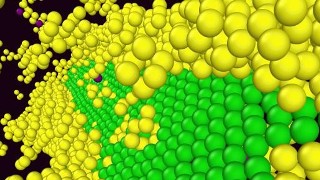Researchers at EPFL’s Laboratory for Multiscale Mechanics Modeling (LAMMM) in the Institute of Mechanical Engineering have solved the mystery behind the low ductility of magnesium.
 © 2015 EPFL
© 2015 EPFL
Prof. William Curtin, The Director of the Institute of Mechanical Engineering and Professor at LAMMM; and Zhaoxuan Wu from the Institute for High Performance Computing in Singapore, have explained the 40-year-old scientific riddle.
Magnesium is the eighth most commonly available element. It is the lightest metal known to exist on Earth. Aluminium is three times heavier, while steel is four times heavier than magnesium. These properties make magnesium a promising material for applications in the automotive industry where reduction in weight is greatly desired. However, this metal is not widely used.
"Magnesium has low ductility, that is, it cannot be stretched very much before it breaks. It also shows unusual behavior, such as a regime of increasing strength with increasing temperature, which is the opposite of most metals”, said Prof. Curtin.
The collaborators successfully identified the atomistic origins behind the metal’s unusual behaviour and low ductility. This finding could enable widespread use of magnesium for various applications.
This astounding discovery had involved long struggles, a new collaboration, tangential advances, and a great finding moment. "I worked for 7 years on magnesium”, says Curtin. “We had some accomplishments, but not on the most crucial issues, and I was about to give up, having exhausted what I thought we could do. But then Wu came from Singapore and brought renewed energy, an array of necessary technical skills, and exceptional motivation”. After two years of collaborative research they managed to solve the riddle.
Based upon a rarely-used description of magnesium, the researchers developed a new description of the atomic interactions that took place in magnesium. This was necessary for studying the true material behaviour of magnesium.
"We came across a rarely-used description of magnesium, and were able to tweak it and arrive at a new interatomic potential that predicted many well-established properties of magnesium with high accuracy.”
The new description was able to predict the structure of the “c a” dislocation accurately. This experimentally observed dislocation had not been predictable earlier. The “c a” dislocation is necessary for the easy flow of magnesium.
The researcher then had a “eureka” moment. “We were performing atomic simulations of the normal “c a” dislocation to better understand its behavior, and suddenly it changed”.
The “c a” dislocation’s atomic structure became completely different. The structure morphed into different geometries that locked and immobilized the dislocation. Magnesium without it’s “c a” motion demonstrated low ductility as it could not flow plastically. Previously, researchers had experimentally observed the new “c a” structures. However, several factors remained unanswered - the way in which they occurred, the reason for numerous different structures, and if any experimental or real anomalies existed.
The present study demonstrated that these new structures were inherent to magnesium, and the reason why different structures arose during different situations. It also showed that these structures demonstrated more stability than the preferred “c a” structure. Wu and Curtin observed that the new “c a” structures would definitely form and then kill magnesium’s ductility.
"To make magnesium malleable, we must fight against the forces of nature," said Wu. If science does not yet have a miracle solution to prevent the phenomenon, he notes that it is still possible to slow the morphing process of the “c a” dislocations. "At room temperature, the morphing occurs almost instantly but when immersed in liquid nitrogen (temperature -195.79°C), it could take several months or one year." If, under normal temperature conditions, it was possible to delay the process for a couple of seconds, then the material could be used on an industrial scale.
Other studies performed in Germany have revealed that magnesium’s ductility could be increased by adding rare elements, such as holonium, erbium or yttrium, to create alloys. The alloying elements may bind to the normal “c a” and stabilize it to a certain extent, when compared to the immovable “c a” dislocations. This method holds significant promise; however, the huge cost of rare elements would be a deterrent for widespread adoption by the automotive industry.
Curtin and Wu are initiating new research on the way in which the normal “c a” could be stabilized using both cheaper and expensive alloys. “We must find a compromise between the cost of the alloy and the material performance” says Prof. Curtin.
While the possibilities of magnesium being commonly used in future cannot be predicted, this study would help develop new ideas. This collaboration has revealed the fundamental reason for magnesium’s poor behaviour.
The study paper has been published in the journal Nature.